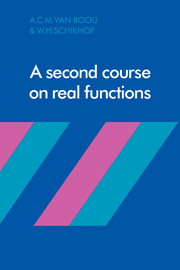Appendixes
Published online by Cambridge University Press: 06 January 2010
Summary
The real number system
Without attempting to compress an entire analysis course into an appendix we want to present a survey of the most elementary facts concerning the real numbers and establish some terminology. We shall not take pains to be systematic about it: we only mention a few points that may not be known to every reader and define terms that otherwise might be ambiguous.
A.I. The real numbers form a set ℝ that is provided with an addition, a multiplication and an ordering that render ℝ a totally (= linearly) ordered field. Other fundamental properties of ℝ will be set out in A.4 and A.5.
In R we have the subsets ℕ, ℤ and ℚ consisting of the natural numbers (= positive integers), the integers and the rational numbers, respectively. There is no need to go into further details here. We merely remark that, if ℝ is considered as a known object, one may define ℕ to be the intersection of all subsets A of ℝ having the property
After this, ℤ and ℚ are easily introduced. (Alternatively, one may start with a set ℕ satisfying Peano's axioms and construct ℝ out of it.)
For a, b ∈ ℝ, we set, as usual,
and so on.
An interval, by definition, is any set of one of these types that contains infinitely many points. (Thus, [1,0], [1, 1) and [1, 1] are legitimate sets but not intervals.)
A subset U of ℝ is open if for every a ∈ U there exists an ε > 0 such that (a – ε,a + ε)⊂ U.
- Type
- Chapter
- Information
- A Second Course on Real Functions , pp. 181 - 195Publisher: Cambridge University PressPrint publication year: 1982



